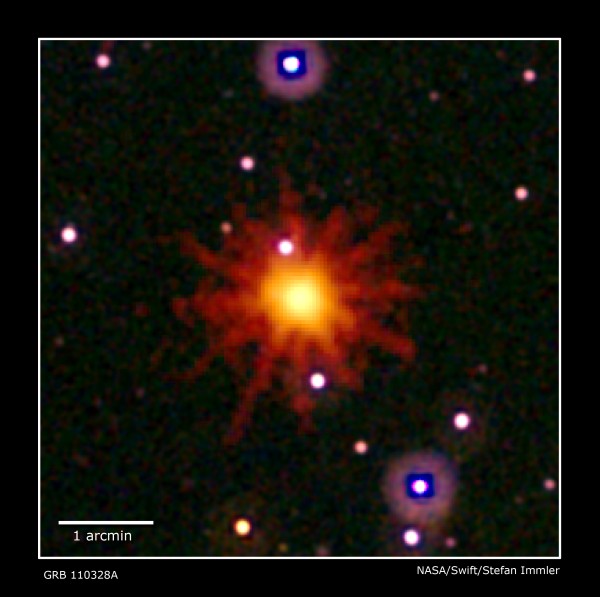Added 1 new A* page:Continuing on from yesterday with the theme of gamma ray bursts, the Swift satellite that detects them, and supermassive black holes, something unprecedented has been observed in the heavens since March 28th of this year! That's when Swift detected a large gamma ray burst--but it didn't stop! Even a burst from a supernova will cut out after a few seconds, but it's been nearly two months now, and from the looks of the Wikipedia article on this burst, GBR 110328A (also known as Swift J164449.3+573451, or Sw J1644+57 for short), it's still going. Here's an image Swift took of it on March 28th, in which the red/yellow X-ray reading is combined with white and purple optical data of nearby objects:

image by NASA (source)
Most gamma ray burst images I've seen from Swift are just blurry red dots; this nice big flared one is unusually powerful, especially considering how long it's been going on. Not only that, but there have been a lot of flares in the signal, suggesting that a dynamic situation took place at the source.
Well, this was big stuff, so big that both Hubble and Chandra--which also reads X-rays, but with more positional precision than Swift--were called into action to take a look, and, according to this NASA article, Hubble spotted a small (apparently unnamed) galaxy at that location, 3.8 billion light years away, and Chandra was able to determine that the burst was coming from the approximate center of that galaxy.
Which means it's probably a jet of material shooting out of a magnetic pole of a supermassive black hole, aimed directly at us. This isn't unusual--that's what most quasars, or more specifically blazars, are thought to be--but this will have been the first time that one has been observed starting up: that is, the first time the supermassive black hole center of a galaxy has been observed going from a dormant to an active phase as a large amount of matter drifts into it and starts getting swallowed up.
That NASA article says the supermassive black hole is probably smaller than A*, the one at the center of our own galaxy (A* is about 4 million solar masses), but this slightly earlier scientific research paper on it estimated the hole to be about five times the mass of ours, or 20 million solar masses; maybe the NASA article shows that number has since been revised.
The article makes the case in detail for the burst being a jet from a newly activated supermassive black hole, showing that the energy curves since the supposed start-up time have differed from the standard curves of blazars or tidal disruption of stars by supermassive black holes. Such events have been inferred from indirect data before, but not observed directly--and those were fairly short events, and didn't have the flaring activity that this one has had. So this really could be the first observed birth of an active galactic nucleus (AGN), and it could end up teaching us a lot about how supermassive black holes and the galactic cores around them change--how galaxies evolve, in fact. Exciting!
|
